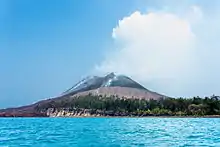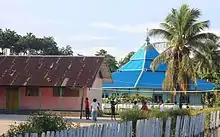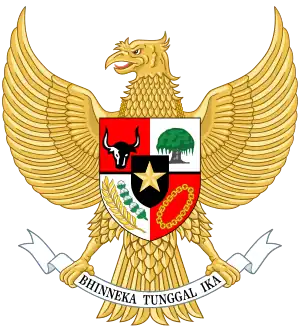Lampung
Lampung, officially the Province of Lampung (Indonesian: Provinsi Lampung), is a province of Indonesia. It is located on the southern tip of the island of Sumatra. It has a short border with the province of Bengkulu to the northwest, and a longer border with the province of South Sumatra to the north, as well a maritime border with the province of Banten and Jakarta to the east. It is the original home of the Lampung people, who speak their own language, and possess their own written script. Its capital is Bandar Lampung.
Lampung | |
|---|---|
| Province of Lampung | |
| Motto(s): | |
| Anthem: Sang Bumi Ruwa Jurai | |
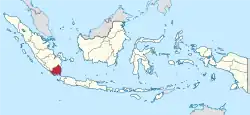 Location of Lampung in Indonesia | |
OpenStreetMap | |
| Coordinates: 5°27′S 105°16′E | |
| Capital and largest city | Bandar Lampung |
| Established | 18 March 1964 |
| Government | |
| • Body | Lampung Provincial Government |
| • Governor | Arinal Djunaidi |
| • Vice Governor | Chusnunia Chalim |
| Area | |
| • Total | 33,575.41 km2 (12,963.54 sq mi) |
| • Rank | 26th in Indonesia |
| Highest elevation (Mount Pesagi) | 2,262 m (7,421 ft) |
| Population (mid 2022 estimate)[2] | |
| • Total | 9,176,546 |
| • Rank | 8th in Indonesia |
| • Density | 270/km2 (710/sq mi) |
| Demonym(s) | Lampungese (in English) Ulun Lappung (in Lampung Nyo) Orang Lampung (in Indonesian) |
| Demographics | |
| • Ethnic groups[3][4] | List |
| • Religion (2022)[5] | List |
| • Languages | Indonesian (official) Lampung and Abung (regional) Javanese, Komering, Sundanese, Balinese |
| Time zone | UTC+7 (Indonesia Western Time) |
| ZIP Codes | 34xxx-35xxx |
| ISO 3166 code | ID-LA |
| Vehicle registration | BE |
| GDP (nominal) | 2022[6] |
| - Total | Rp 414.1 trillion (11th) US$ 27.9 billion US$ 87.0 billion (PPP) |
| - Per capita | Rp 45.1 million (25th) US$ 3,039 US$ 9,484 (PPP) |
| - Growth | |
| HDI | |
| Website | lampungprov |
The province covers a land area of 33,575.41 sq.km and had a population of 7,608,405 at the 2010 census,[8] 9,007,848 at the 2020 census,[9] and 9,176,546 according to the official estimates for mid 2022,[2] with three-quarters of that being descendants of Javanese, Madurese, and Balinese migrants. These migrants came from more densely populated islands, in search of available land, as well as being part of the national government's Indonesian transmigration program, of which Lampung was one of the earliest and most significant transmigration destinations.
On 10 May 2005, a 6.4 magnitude earthquake struck the province. In 1883, the volcano of Krakatoa, located on an island in the Sunda Strait, suffered one of the most violent volcanic eruptions in recorded history, with disastrous consequences for the area and elsewhere, including estimates of human fatalities in the tens of thousands, and worldwide temperature and other weather effects for years.
| Year | Pop. | ±% |
|---|---|---|
| 1971 | 2,777,008 | — |
| 1980 | 4,624,785 | +66.5% |
| 1990 | 6,017,573 | +30.1% |
| 1995 | 6,657,759 | +10.6% |
| 2000 | 6,741,439 | +1.3% |
| 2005 | 7,116,177 | +5.6% |
| 2010 | 7,608,405 | +6.9% |
| 2015 | 8,109,601 | +6.6% |
| 2020 | 9,007,848 | +11.1% |
| 2022 | 9,176,546 | +1.9% |
| Source: Badan Pusat Statistik 2023 and previous | ||
History
In the 7th century, word spread throughout China of a region located in the far south (Namphang) known as "Tolang Pohwang", it is referred to Tulang Bawang Regency or regions alongside the Tulang Bawang River. Lampung was part of the Srivijaya empire, with its regional capital in Jambi, which controlled most of Southeast Asia until the 11th century era. The Srivijayans came to Lampung in search of gold and amber, two of the province's natural resources.
This history is substantiated by, unearthed relics and the discovery of the Palas Pasemah inscriptions and the Batu Bedil inscriptions in the Tenggamus region that trace back to Srivijayan times. Other, smaller kingdoms like Tulang Bawang. And Sekala Brak kingdoms maritime existed during the 7th to 8th centuries CE.
The entry of the Banten Sultanate in Lampung in the 16th century marked the beginning of the spread of Islam in the region. Lampung is known for pepper which at that time was in high demand. At that time, the Dutch began pressing for control of the region.[10] In the 1930s Lampung still accounted for 30% of the world's pepper production.[11]
The control of pepper production exercised by the Banten Sultanate made Lampung one of the most prosperous harbors in the archipelago. Similarly, pepper plants also attracted migrants from Europe as employees of trading companies. It was in 1610 that the Dutch East India Company established a trading post in Banten and later in the 17th century began the forceful pepper cultivation in Lampung to increase its already existing production.[12] The area was part of the Banten Sultanate until it was annexed by the Dutch in 1752, when it became known as the Residentie Lampoengse Districten.[13] It became part of the Dutch East Indies.
Under Dutch rule, transmigration programs were implemented. This program involved the migration of people from Java to Lampung. It was quite well-received and many residents of Java moved to the transmigration sites located in the eastern region of Lampung.[14] The program was expanded after Indonesian independence in the 1960s. The Javanese brought cultural devices to Lampung, such as the gamelan and wayang. Balinese also came to Lampung to follow the transmigration program. The presence of migrants from other regions in Lampung has made this region culturally diverse. Ethnic diversity has become a tourist attraction in itself, with the added potential of nature and cultural tourism. Numerous art studios in the area act as a preserver of indigenous art and culture.
Geography
Lampung Province has an area of 33,575.41 km2 (12,963.54 sq mi) and is located between the latitudes of 105°45'-103°48 'E and 3°45'-6°45'S. The province borders the Sunda Strait to the southeast and the Java Sea to the east. There are a number of offshore islands within Lampung Province, such as: Daro, Legundi, Tegal, Sebuku, Ketagian, Sebesi, Poahawang, Krakatoa, Putus, and Tabuan. These islands are located mostly in the Bay of Lampung. Pisang Island lies at the entrance to the Regency of West Lampung.
Lampung's natural terrain varies depending on the region. Along the coast in the west and the south is an area of rolling hills connected to the Bukit Barisan mountain range, running throughout Sumatra from north to south. In the center of the province is mostly lowland. Close to the coast in the east, along with the shores of the Java Sea, further north, is the great waters.
The mountains situated in Lampung by height include:
- Mount Pesagi (2,262 m [7,421 ft]) in Liwa, West Lampung
- Mount Seminung (1,881 m [6,171 ft]) in Sukau, West Lampung
- Mount Tebak (2,115 m [6,939 ft]) in Sumberjaya, West Lampung
- Mount Rindingan (1,506 m [4,941 ft]) on the island stage, Tanggamus
- Mount Pesawaran (1,662 m [5,453 ft]) in Kedondong, Pesawaran
- Mount Betung (1,240 m [4,070 ft]) in Teluk Betung, Bandar Lampung
- Mount Rajabasa (1,261 m [4,137 ft]) at the Trump, South Lampung
- Mount Tanggamus (2,156 m [7,073 ft]) in Kotaagung, Tanggamus
- Mount Krakatau in the Sunda Strait, South Lampung
- Mount Sekincau Liwa, West Lampung
- Mount Ratai in Padang Cermin, Pesawaran
The rivers that flow in Lampung by length and catchment area (CA) are:
- Way Sekampung, length 265 km (165 mi), CA 4,795.52 km2 (1,851.56 sq mi)
- Way Semaka, length of 90 km (56 mi), CA 985 km2 (380 sq mi)
- Way Seputih, length 190 km (120 mi), CA 7,149.26 km2 (2,760.34 sq mi)
- Way Jepara, 50 km (31 mi), CA 1,285 km2 (496 sq mi)
- Way Tulangbawang, length 136 km (85 mi), CA 1,285 km2 (496 sq mi)
- Way Mesuji, length 220 km (140 mi), CA 2,053 km2 (793 sq mi)
- Way Sekampung, flowing in the district Tanggamus, Pringsewu, Pesawaran and South Lampung. Many tributaries, but no longer than 100 km (62 mi). There is only one long river 51 km (32 mi) to CA 106.97 km2 (41.30 sq mi) is in the Trump Way Ketibung.
- Way Putih flows in Central Lampung regency with tributaries that are longer than 50 km (31 mi) are:
- Way Terusan, 175 km (109 mi) long, CA 1,500 km2 (580 sq mi)
- Way Pengubuan, length 165 km (103 mi), CA 1,143.78 km2 (441.62 sq mi)
- Way Pegadungan, a length of 80 km (50 mi), CA 975 km2 (376 sq mi)
- Way Raman, length 55 km (34 mi), CA 200 km2 (77 sq mi)
- Way Tulangbawang flows in the district Tulangbawang with creeks more than 50 km (31 mi) in length, of which:
- Way Kanan, length 51 km (32 mi), CA 1,197 km2 (462 sq mi)
- Way Rarem, length 53.50 km (33.24 mi), CA 870 km2 (340 sq mi)
- Way Umpu, a length of 100 km (62 mi), CA 1,179 km2 (455 sq mi)
- Way Tahmy, a length of 60 km (37 mi), CA 550 km2 (210 sq mi)
- Way Besay also supplies a length of 113 km (70 mi), CA 879 km2 (339 sq mi)
- Way Giham, a length of 80 km (50 mi), CA 506.25 km2 (195.46 sq mi)
- Way Mesuji flows on the border of the provinces of Lampung and South Sumatra and to the north has a tributary named Crocodile River, along the 70 km (43 mi) by CA 347.5 km2 (134.2 sq mi).
Forests in the lowlands have been exhausted after being appropriated for agricultural development, which is needed for the migrants constantly entering this area. Timber forest products are exported abroad. Some forests remain in the area of Bukit Barisan Selatan.
Cities and towns in the province of Lampung with a height of 50 meters above sea level are: Tandjungkarang (96 m [315 ft]), Kedaton (100 m [330 ft]), Metro (53 m [174 ft]), Gisting (480 m [1,570 ft]), State Sakti (100 m [330 ft]), Pringsewu (50 m [160 ft]), Pekalongan (50 m [160 ft]), Batang (65 m [213 ft]), Punggur (50 m [160 ft]), Padang Queen (56 m [184 ft]), Wonosobo (50 m [160 ft]), Kedondong (80 m [260 ft]), Sidomulyo (75 m [246 ft]), Kasui (200 m [660 ft]), Sri Menanti (320 m [1,050 ft]) and Liwa (850 m [2,790 ft]).
Administrative divisions
Lampung Province, which was formed from the southern portion of South Sumatra Province in 1964, was initially composed of just three regencies (kabupaten) - Lampung Selatan, Lampung Tengah and Lampung Utara - and one autonomous city (kota) - Bandar Lampung. A fourth regency (Lampung Barat) was created on 16 August 1991 from part of Lampung Utara, and on 3 January 1997 two further regencies were created - Tanggamus from part of Lampung Selatan, and Tulang Bawang from part of Lampung Utara. On 20 April 1999 two additional regencies were formed - Lampung Timur from part of Lampung Tengah, and Way Kanan from part of Lampung Utara - as well as a second autonomous city - Metro - from another part of Lampung Tengah.
A ninth regency (Pesawaran) was created on 17 July 2007 from a further part of Lampung Selatan, and on 29 October 2008 three more regencies were formed - Mesugi and Tulang Bawang Barat from parts of Tulang Bawang Regency, and Pringsewu from part of Tanggamus Regency. Finally a thirteenth regency (Pesisir Barat) was formed on 25 October 2012 from the west coast part of Lampung Barat Regency. These are all listed below with their areas and their populations at the 2010[8] and 2020[9] censuses, and at the mid 2022 official estimates.[2]
| Kode Wilayah | Name of City or Regency | Area in km2 | Pop'n census 2010 | Pop'n census 2020 | Pop'n estimate mid 2022 | Capital | HDI 2018 Estimates |
|---|---|---|---|---|---|---|---|
| 18.71 | Bandar Lampung City | 183.72 | 881,801 | 1,166,066 | 1,209,937 | Bandar Lampung | 0.766 (High) |
| 18.72 | Metro City | 73.21 | 145,471 | 168,676 | 171,169 | Metro | 0.762 (High) |
| 18.02 | Central Lampung Regency (Lampung Tengah) | 4,548.93 | 1,170,717 | 1,460,045 | 1,500,002 | Gunung Sugih | 0.697 (Medium) |
| 18.07 | East Lampung Regency (Lampung Timur) | 3,868.43 | 951,639 | 1,110,340 | 1,127,946 | Sukadana | 0.690 (Medium) |
| 18.11 | Mesuji Regency | 2,200.51 | 187,407 | 227,518 | 232,685 | Mesuji | 0.628 (Medium) |
| 18.03 | North Lampung Regency (Lampung Utara) | 2,656.39 | 584,277 | 633,099 | 635,129 | Kotabumi | 0.671 (Medium) |
| 18.09 | Pesawaran Regency | 1,279.60 | 398,848 | 477,468 | 487,153 | Gedong Tataan | 0.649 (Medium) |
| 18.10 | Pringsewu Regency | 614.97 | 365,369 | 405,466 | 408,415 | Pringsewu | 0.694 (Medium) |
| 18.01 | South Lampung Regency (Lampung Selatan) | 2,218.84 | 912,490 | 1,064,301 | 1,081,115 | Kalianda | 0.678 (Medium) |
| 18.06 | Tanggamus Regency | 2,901.98 | 536,613 | 640,275 | 652,898 | Kota Agung | 0.656 (Medium) |
| 18.05 | Tulang Bawang Regency | 3,107,47 | 397,906 | 430,021 | 431,208 | Menggala | 0.677 (Medium) |
| 18.08 | Way Kanan Regency | 3,531.10 | 406,123 | 473,575 | 481,036 | Blambangan Umpu | 0.666 (Medium) |
| 18.04 | West Lampung Regency (Lampung Barat) | 2,116.01 | 277,296 | 302,139 | 303,397 | Liwa | 0.667 (Medium) |
| 18.13 | Pesisir Barat Regency | 2,993.80 | 141,741 | 162,697 | 164,816 | Krui | 0.629 (Medium) |
| 18.12 | West Tulang Bawang Regency (Tulang Bawang Barat) | 1,281.45 | 250,707 | 286,162 | 289,620 | Panaragan Jaya | 0.653 (Medium) |
| Total Province | 33,575.41 | 7,608,405 | 9,007,848 | 9,176,546 | Bandar Lampung | 0.690 (Medium) |
Agriculture
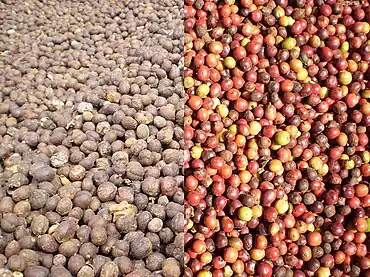
Major crops in the region include robusta coffee beans, cocoa beans, coconuts and cloves. This has resulted in a thriving agricultural sector with companies like Nestlé procuring coffee beans from the region. This agriculture has included illegal growing in Bukit Barisan Selatan National Park.[15] In addition, nata de coco is also manufactured in the region by domestic companies like Wong Coco.
Textiles
_in_adatkostuum_TMnr_10002793.jpg.webp)
Until the 1920s, Lampung had a rich and varied weaving tradition. Lampung weaving used a supplementary weft technique which enabled colored silk or cotton threads to be superimposed on a plainer cotton background. The most prominent Lampung textile was the Palepai, ownership of which was restricted to the Lampung aristocracy of the Kalianda Bay area.[16]
There were two types of smaller clothes, known as tatibin and tampan, which could be owned and used by all levels of Lampungese society. Weaving technologies were spread throughout Lampung. High-quality weavings were produced by the Paminggir, Krui, Abung and Pesisir peoples. Production was particularly prolific among the people of the Kalianda Bay area in the south and the Krui aristocracy in the north.
Lampung textiles, Palepai, tatebin and tampan were called 'ship cloths' because ships are a common motif.[17] The ship motif represents the transition from one realm of life to the next, for instance from boyhood to manhood or from being single to married, and also represents the final transition to the afterlife.[16]
Traditionally, Lampung textiles were used as part of religious ceremonies such as weddings and circumcisions. For instance, Palepai cloths were used as long ceremonial wall-hangings behind the bridal party in aristocratic marriages. The smaller, more humble tampan cloth was exchanged between families at the time of weddings.
Production of fine cloth blossomed in the late nineteenth century as Lampung grew rich on pepper production, but the devastating eruption of Krakatoa in 1883 destroyed many weaving villages in the Kalianda area.[18] By the 1920s the increasing importance of Islam and the collapse of the pepper trade brought production to a halt.[19] Today Lampung textiles are highly prized by collectors.
Tourism
Although tourism is not Lampung Province's main source of income, the administration has attempted to boost tourism through many ways, mainly from beaches, such as Flamboyant Tanjung Setia. This attraction seeks to draw tourists to Tanjung Setia Beach, which has a natural panoramic view and a spot for surfing. There is also Pahawang Island and Sari Ringgung beach, which is also a popular tourist destination in Lampung. Lampung also has a national park, the Way Kambas National Park, which attracts many domestic and international tourists.[20] In 2010, four-hundred thousand tourists visited Lampung Province, including ten thousand foreign tourists mainly from Australia and New Zealand.[21]
Way Kambas National Park is a national park and elephant sanctuary in the district of Labuhan Ratu, East Lampung. In addition to Way Kambas, another elephant school (Elephant Training Centre) can also be found in Minas, Riau. The number of Sumatran elephants (Elephas maximus sumatranus) living in the region has decreased. Way Kambas National Park was established in 1985 as the first elephant school in Indonesia and is expected to become a center for elephant conservation in taming, training, breeding and conservation. Until now, this PKG has trained about three hundred elephants that have been deployed to other parts of the country.
In recent years, the province has become largely popular for snorkeling and diving. Many domestic tourists, as well as international ones from various diving communities, visit the spots the province offers, such as: Pantai Ringgung, Pulau Tegal, Pulau Pahawang, Pulau Kelagian, Pulau Balak, Pulau Mahitam, and Tanjung Putus.
Demographics
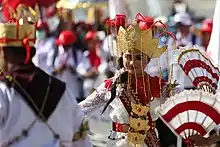
Lampung's three major ethnic groups are the Javanese, Lampungese and Sundanese. The Lampungese are the native ethnic group of the province. Languages used in the province include Indonesian (official), Javanese, Sundanese, Balinese, Minangkabau and Lampung. According to the Indonesian census from 2010 the province of Lampung is 64,17 percent Javanese, 13,56 percent Lampungese, 5,64 percent Malay and 0,53 percent Chinese.
Transport
Land
In the province of Lampung, the Bakauheni-Terbanggi Besar Toll Road spans from Bakauheni in South Lampung to Terbanggi Besar in Central Lampung along 140.9 kilometres (87.6 mi) was completed in March 2019.[23] The toll road has been under construction since April 2015.[24] As for the cost of development, is predicted to reach Rp 53 trillion, including land acquisition and construction of approximately Rp 30 trillion.[25] North of Terbanggi Besar to Kayu Agung (South-Sumatra), another toll road is under construction as part of the Trans-Sumatra toll road. This part will be finished in 2019.[26] Lampung has a bus terminal at Terminal Rajabasa which is one of the biggest and busiest in Sumatra and Lampung, as well as the Talbot terminal in Bandar Lampung. Rajabasa airport's terminal at close range, intermediate, and far (AKAP) which has bus routes to cities in Sumatra and Java.
In addition to these two terminals, there are bus terminals located throughout the capital district in Lampung.
Sea
In the province, there are several ports. The Port of Panjang is an import-export harbor and Port Srengsem which serves the traffic coal distribution from South Sumatra to Java. About 92 kilometres (57 mi) south of Bandar Lampung, lies the port city of Bakauheni, precisely at the southern tip of Sumatra. Located at the southern end of the Trans-Sumatran Highway, the Bakauheni port connects Sumatra to the Port of Merak in Java via sea transportation.
Air
Radin Inten II International Airport is the only airport in the province. It serves flights to Banten, Jakarta, Majalengka, Medan, Bandung, Palembang, Semarang, Surabaya, Surakarta, Yogyakarta and more.
Rail
Lampung Province has a railway line between Bandar Lampung - Palembang, which is part of a railway network in South Sumatra operated by Kereta Api Indonesia Divre IV Tanjung Karang, located in Bandar Lampung. Bandar Lampung - Palembang railway line holds forty stations along 387,872 km (241,012 mi) stretches between Tanjung Karang station in Bandar Lampung to Kertapati station in Palembang.
Sports
The 15,000-capacity Pahoman Stadium is the main stadium in Lampung. The association football stadium opened in 1977.[27]
See also
References
- "Kenali Motto Kabupaten/Kota di Provinsi Lampung".
- Badan Pusat Statistik, Jakarta, 2023, Provinsi Lampung Dalam Angka 2023 (Katalog-BPS 1102001.18)
- "Kewarganegaraan, Suku Bangsa, Agama, dan Bahasa Sehari-hari Penduduk Indonesia" (pdf). www.bps.go.id. pp. 36–41. Retrieved 22 September 2021.
- Ananta, Aris (2015). Demography of Indonesia's Ethnicity. Evi Nurvidya Arifin, M. Sairi Hasbullah, Nur Budi Handayani, Agus Pramono. SG: Institute of Southeast Asian Studies. ISBN 978-981-4519-88-5. OCLC 1011165696.
- "ArcGIS Web Application".
- Badan Pusat Statistik (2023). "Produk Domestik Regional Bruto (Milyar Rupiah), 2020–2022" (in Indonesian). Jakarta: Badan Pusat Statistik.
- Badan Pembangunan Nasional (2023). "Capaian Indikator Utama Pembangunan" (in Indonesian). Jakarta: Badan Pembangunan Nasional.
- Biro Pusat Statistik, Jakarta, 2011.
- Badan Pusat Statistik, Jakarta, 2021.
- Changes of Regime And Social Dynamics in West Java: Society, State And the Outer World of Banten, 1750-1830
- Safitri, Myrna Asnawati (2010). "9. Social forest in Langkawana: from license to supervision" (PDF). Forest tenure in Indonesia: the socio-legal challenges of securing communities' rights (PhD thesis). Leiden University.
- Southeast Asia: A Historical Encyclopedia, from Angkor Wat to East Timor, Volume 1
- "Lampung Arms". www.hubert-herald.nl. Retrieved 24 July 2016.
- Pratiwi, Ayu; Matous, Petr; Martinus, Kirsten (1 October 2022). "Transmigration programs and migrant positions in rural community knowledge networks". Journal of Rural Studies. 95: 391–401. doi:10.1016/j.jrurstud.2022.09.019. ISSN 0743-0167.
- Leow, Claire (19 January 2007). "Nestlé to scrutinize Indonesia coffee amid wildlife-endangerment fears". International Herald Tribune. Archived from the original on 22 January 2007.
- "Ceremonial Hanging (palepai)". Pacific Islands art. Dallas Museum of Art. Archived from the original on 4 October 2006. Retrieved 26 September 2007.
- Gittinger, Mattiebelle (1979). Splendid Symbols: Textiles and Tradition in Indonesia. Washington DC: The Textile Museum. p. 157. LCCN 79-50373. OCLC 5100926.
- Gittinger, Mattiebelle S. (1979). "SOUTH SUMATRAN SHIP CLOTHS" (PDF). p. 15. Archived from the original (PDF) on 3 February 2016.
- Sudha Rajagopalan; Navigating Culture: Trade and Transformation in the Island State. The Permanent Exhibition on Indonesia. Museum Volkenkunde, Leiden.
- "THE 15 BEST Things to Do in Lampung - 2021 (with Photos)". Tripadvisor. Retrieved 12 May 2021.
- "Waspada Online – Pusat Berita dan Informasi Medan Sumut Aceh". Waspada.co.id. Retrieved 24 July 2016.
- "Peringatan".
- "Presiden Jokowi Resmikan Tol Bakauheni-Terbanggi Besar, Terpanjang di Indonesia" (in Indonesian). 8 March 2019.
- "Presiden Jokowi Hari ini Akan Lakukan Groundbreaking Jalan Tol Bakauheni". Tribunnews.com.
- Prabawati Sriningrum (9 January 2015). "Pemerintah Bangun Tol Bakauheni-Terbanggi Besar di 2015". Okezone (in Indonesian).
- "Addendum for Terbanggi Besar Toll road signed". 11 January 2019.
- "Pahoman Stadium - Soccerway". int.soccerway.com.
Further reading
- Elmhirst, R. (2001). Resource Struggles and the Politics of Place in North Lampung, Indonesia. Singapore Journal of Tropical Geography. 22(3):284–307.
- Pain, Marc (ed). (1989). Transmigration and spontaneous migrations in Indonesia: Propinsi Lampung. Bondy, France: ORSTOM.
- Totton, Mary-Louise (2009) Wearing Wealth and Styling Identity: Tapis from Lampung, South Sumatra, Indonesia. Hood Museum of Art, Dartmouth College.
External links
- Early Indonesian textiles from three island cultures: Sumba, Toraja, Lampung, an exhibition catalog from The Metropolitan Museum of Art Libraries (fully available online as PDF), which contains material on Lampung

